If you’re a screen size junkie — someone who believes that when it comes to TVs, bigger is always better — you might want to take a look at a laser TV. No, it’s not a TV in the traditional sense of the word, and even though real lasers are involved, you won’t be accidentally zapping holes in your walls, furniture, or family members (sorry).
- What is a laser TV?
- All about ALR screens
- How is a laser TV different from other kinds of projectors?
- Are all laser TVs more or less the same?
- How big is a laser TV image?
- Can laser TVs do HDR?
- Are laser TVs good for gaming?
- Who makes laser TVs?
- Who should buy a laser TV?
- What else should I know about laser TVs?
Laser TVs are essentially just laser-powered ultra short throw (UST) projectors. But if you’re shopping for one, you may notice that this definition doesn’t always apply. Different brands include different features and accessories with their laser TVs, which means you’ll need to do your homework before you buy.
But don’t worry, we’re going to explain everything you need to know
What is a laser TV?
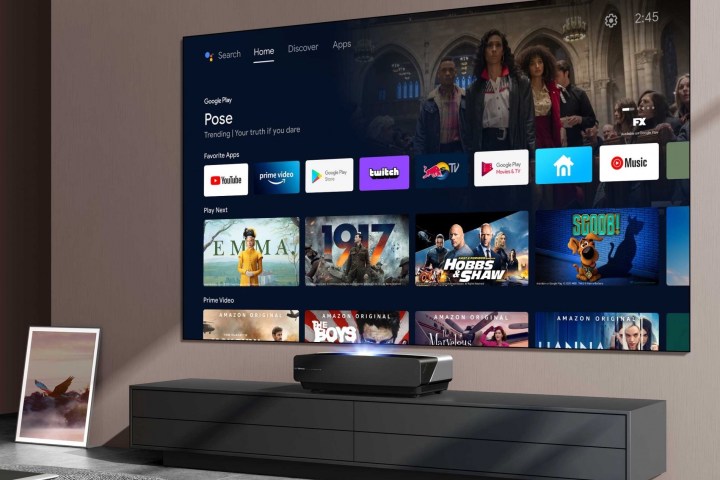
The home-theater industry seems to be a bit conflicted when it comes to the actual definition of the term laser TV, so let’s cover all of the permutations.
At a minimum, a laser TV is an ultra short throw projector powered by a laser light source, with a built-in sound system consisting of one or more speakers. With image sizes ranging from 90 to 150 inches, they’re a plug-and-play alternative to a big-screen TV — and way more affordable on an inch-by-inch basis. Why lasers? They’re far brighter and last a lot longer than conventional LEDs and high-pressure bulbs. The very best IMAX theaters use laser projectors — sometimes two at once.
If at this point you’re asking if a laser TV really is just a laser projector, you’re not entirely wrong.
But there’s more to the laser TV story. In order for a laser-powered UST projector to truly replace your current TV, it also needs a dedicated projection screen (more on this in a moment), a built-in ATSC tuner for receiving free over-the-air broadcasts, and a built-in smart TV operating system, like Google TV, which can give you access to your favorite streaming apps.
With me so far? OK, here’s where we get into marketing lingo territory. The term “laser TV” actually dates back to the 1970s, but it never caught on as a mainstream product. Hisense revived it in 2007 when it introduced its first laser UST projector and it has been using the term on its laser products ever since. However, at CES 2023, the company announced that it is now going to use the term exclusively to mean UST laser projectors that have a fixed image size, and come with a matching screen. It will continue to sell UST laser projectors that aren’t packaged with screens, and which can project varying image sizes, but these will be known as “Laser Cinema” products.
Hisense’s rationale for the new distinction is that a true laser TV should be no different from a regular TV. You pick the size and features that matter to you, and then everything you need is in the box. Why pay more for a UST projector that has a motorized lens and other expensive components if you have no intention of changing the size of the image?
But Hisense doesn’t own the term laser TV. It’s not trademarked. Any company can sell a laser-powered projector and call it a laser TV, so Hisense’s definition won’t necessarily become the standard.
All about ALR screens
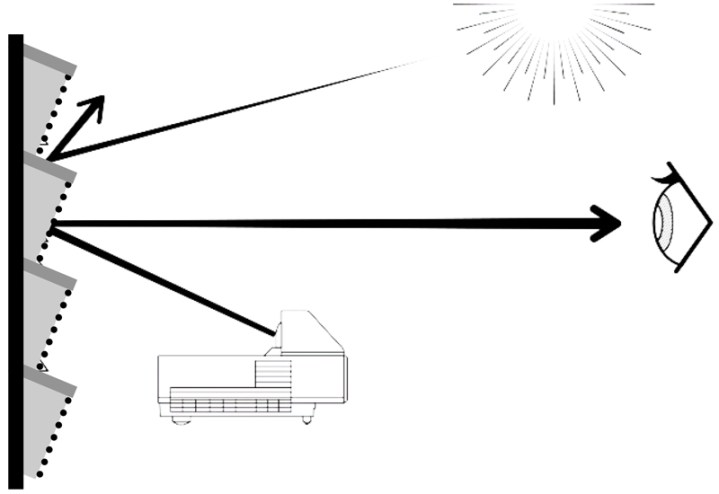
For the moment, let’s stick with Hisense’s definition of laser TV because the included screen is kind of a big deal.
Like all projectors, the light from a laser TV isn’t experienced directly as it would be from a regular TV. Instead, it bounces off a surface first, and then it reaches our eyes.
That surface plays a huge role in the quality of the final image. It can affect the color balance if it’s not a precise shade of white or neutral gray and it can rob the image of brightness if it’s got a deeply matte finish because it will absorb, rather than reflect the incoming light. Conversely, if it’s got a highly reflective surface, ambient light from the room could get mixed in with the light from the projector, leading to a washed-out, low-contrast image.
These are just some of the reasons why a bare wall is not the ideal surface for a normal projector. But when it comes to UST projectors, regular walls are even worse.
UST projectors aim their light at a very acute angle to the wall, which normally means that the light will be reflected at an equally acute angle (and thus, not toward your eyes). Then there are the imperfections of home construction. It’s very likely your wall isn’t completely straight, or free from imperfections. Or maybe there’s some texture to it. Or all three. None of that is an ideal surface on which to watch video. (We’ve tried.)
An ambient light-rejecting (ALR) screen conveniently addresses all of these concerns. It’s got the right color, it’s highly reflective, its micro-textured surface bounces the UST light directly at your viewing position, and it prevents stray (ambient) light from getting mixed in with the light from the image. In other words, it makes a really big difference to the UST experience, which is why Hisense always includes an ALR screen with its Laser TVs.
There’s nothing stopping you from buying a laser UST projector and adding your own ALR screen. But with Hisense’s definition of a laser TV, figuring out the kind and size of ALR screen has been done for you. All you have to do is pay.
How is a laser TV different from other kinds of projectors?
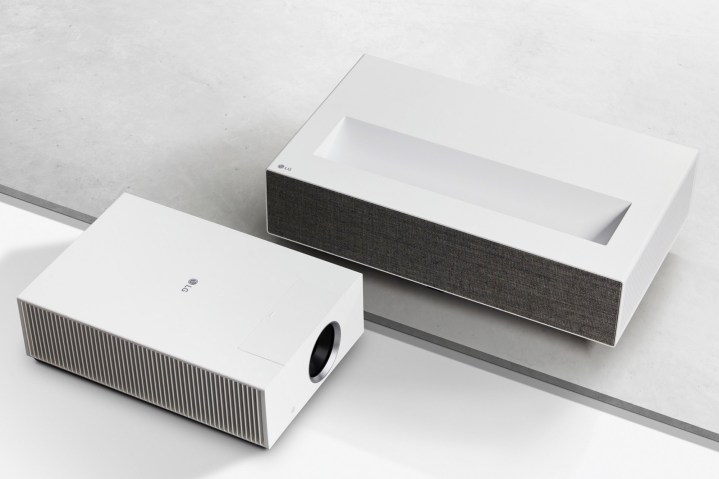
Most projectors (laser or otherwise) are intended to display large images on a flat surface from a distance. They’re often suspended from ceilings or placed near the back of a room, making them the home-theater equivalent of a commercial movie theater projection system. They rarely have their own speakers, smart TV software, or wireless connections like Bluetooth and Wi-Fi. They’re strictly for showing big images. You’ll need to provide a content source, a screen (if you want), and a sound system.
UST projectors can achieve similarly large image sizes, but they project them from much smaller distances — often 15 inches or less from a wall or screen. They sit almost directly under the display surface, and they’re usually front and center in any room, making them an ideal location for speakers, too, which is why most UST projectors typically include some kind of sound system and smart TV features. This makes for a much less intrusive installation, because it’s all-in-one, with only a single power cord to run.
Like regular projectors, many UST models can project images at a variety of sizes when you combine the zoom capabilities of their lenses and their distance from the display surface. Because of this varying size capability, UST and regular projectors are almost never packaged with their own screens — it’s better to let the buyer decide what type and size of screen works for their space (or maybe they won’t use a screen at all).
Hisense’s Laser TV concept simply takes the UST formula to the next logical place: It’s a laser-powered UST projector with a lens that has been fixed to a specific image size that comes with its own screen with the correct dimensions for that image. It makes the buying experience much easier — pick the size of image you want, and walk home with everything you need.
Are all laser TVs more or less the same?

There can be some pretty big differences among laser TVs, which is why you’ll see prices that range from under $2,000 to well over $8,000. The biggest differences are the brightness, the number of lasers, and the color of those lasers.
The brighter the laser, the better your projected image will look in a variety of lighting conditions. Brightness also is key to getting the best HDR performance. It’s measured in lumens and ANSI lumens, which means you’ll have to do some due diligence because they’re not exactly the same. Lumens is a straight-up measurement of the maximum brightness of the light that exits the lens, whereas ANSI lumens takes several other factors into consideration to produce a more real-world number.
If there are two laser TVs side by side, one with 2,500 lumens and one with 2,500 ANSI lumens, the ANSI lumens projector will be brighter. It’s not a perfect formula, but a good guideline is: take the stated lumens value and divide it by 2.4 to get the ANSI lumens number. e.g. 2,500 lumens is only 1,041 ANSI lumens.
Lower-end laser TVs use a single, blue laser with a color wheel that can convert the blue light into red and green, for the full spectrum. These models typically offer a high percentage of the Rec. 709 color space — the minimum set of colors for most broadcast/streaming shows and movies — but they can also suffer from something known as the rainbow effect.
More expensive models use two lasers, often a red and blue laser, with the blue laser getting converted to green when that color is needed. These can deliver up to 100% of the DCI-P3 color space, which is the standard for digital projection in commercial theaters.
The best laser TVs use three separate red, green, and blue lasers. They tend to be the brightest, and they can often exceed the BT.2020 color space, a standard that goes well beyond the number of colors currently in use for movies or TV shows. Still, it’s nice to be future-proofed.
As with TVs, you’ll find models that support 8K resolution, HDMI 2.1, and modern surround sound formats like Dolby Atmos and DTS:X. And if you want a laser TV to be a true replacement for a regular TV, look for a model that has a built-in ATSC 1.0 or ATSC 3.0 tuner so you can receive and watch free over-the-air TV from an antenna.
How big is a laser TV image?
You can buy laser TVs capable of producing images that start at 90 inches and go as large as 150 inches but remember, some laser TVs have fixed sizes, while others are adjustable.
Can laser TVs do HDR?
Yes, HDR (high dynamic range) is supported by most laser TVs, but you’ll need to pay close attention if you want support for a specific HDR format, like HDR10+ or Dolby Vision. These formats have stricter requirements for color and brightness than HDR10, and not all laser TVs meet them.
Are laser TVs good for gaming?
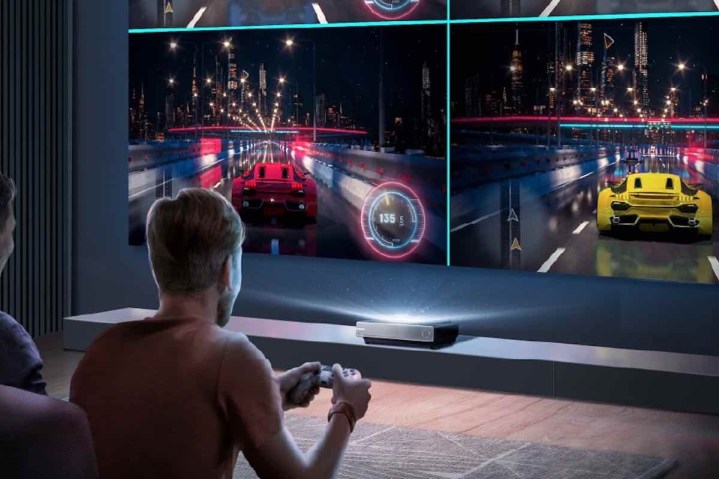
Laser TVs are best for games that benefit from being played on a big screen, but where reaction times aren’t absolutely critical. That’s due to their longer latency times when compared to OLED or traditional LED TVs. Some laser TVs have game modes that dramatically reduce this latency. But for fast-twitch gaming, it’s still better to stick with a conventional TV.
Who makes laser TVs?
At the moment, only Hisense and Epson make laser TVs that follow Hisense’s new definition (fixed size, screen included), with Hisense-built Leica models on the way. But you’ll find the other kind of laser TVs (variable size, no screen) from a variety of companies including LG, Samsung, Vava, Formovie, AWOL, and BenQ — just to name a handful.
Who should buy a laser TV?
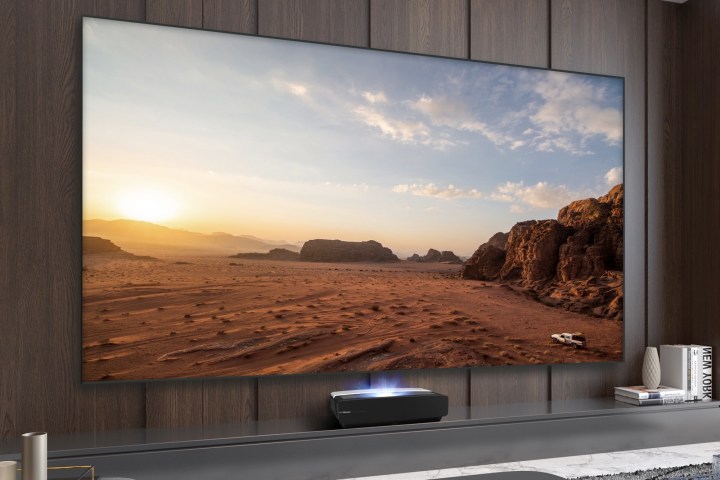
Anyone who wants a TV with a screen size larger than 86 inches should consider a laser TV. Conventional TVs — especially OLED TVs — start to cost well north of $10,000 once they’re larger than 86 inches, at which point laser TVs become far more cost-effective.
However, there are additional considerations. Laser TVs still work best in darker environments, so it’s best not to think of them simply as really large TVs. And even the best laser TVs can’t match the superb black levels of an OLED TV or the brightness of a QLED TV, which means you’ll need to set your expectations accordingly.
You’ll also need an appropriate space for your laser TV and screen. Even though the laser TV projection unit can sit very close to the wall on which you’ll mount the screen, it needs anywhere from 12 to 17 inches of vertical space below the bottom of the screen. Check out some of the images on this page — you’ll see the laser TVs are all located fairly low to the ground.
What else should I know about laser TVs?
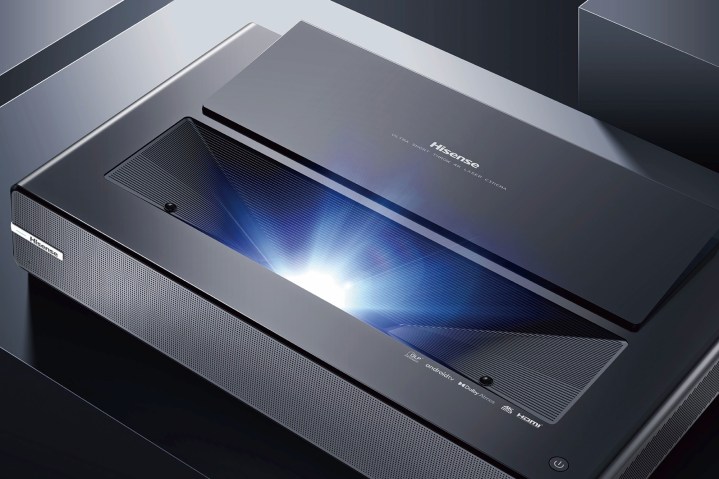
The laser inside a laser TV might not be able to cut through steel (or even paper), but it gets very bright — bright enough to harm your eyes if you look directly at it. Most laser TVs have proximity sensors that will automatically shut off the laser in case you (or perhaps a child) get too close, but it’s still something to be aware of. That powerful light also generates a good bit of heat, so you’ll likely be aware of the laser TV’s cooling fans. Most are quiet enough that you won’t hear them if you’re playing a show or movie even at moderate volumes, but some people are more sensitive to it than others.
ALR screens — whether included with the projector or not — can be tricky to assemble and install. Companies are getting better at designing them, but it’s still a multi-step process that requires patience and almost certainly an extra set of hands. Mounting the screen correctly is also a challenge that buyers don’t always consider. If you’re not sure if you can do it yourself, it’s worth the cost to hire a pro.
Pick your screen size with care. Unlike other UST or conventional projectors, most laser TVs are specifically tuned to project one size of image. They must sit at a precise distance from the screen in order to deliver a perfectly sharp picture. Each unit has its own specific measurements, so make sure you can accommodate your chosen model/size combo.
Like most TVs — even high-end TV models — laser TVs aren’t going to deliver top-notch home theater sound. Expect to buy a soundbar or component system if you want your audio to be as big and as exciting as the image.
Depending on the smart TV software that comes installed, you may want to use an external streaming device like an Apple TV or a Roku. Many now come with Google TV, but you’ll still find plenty that run dodgy versions of the open-source Android TV software. Better safe than sorry.



